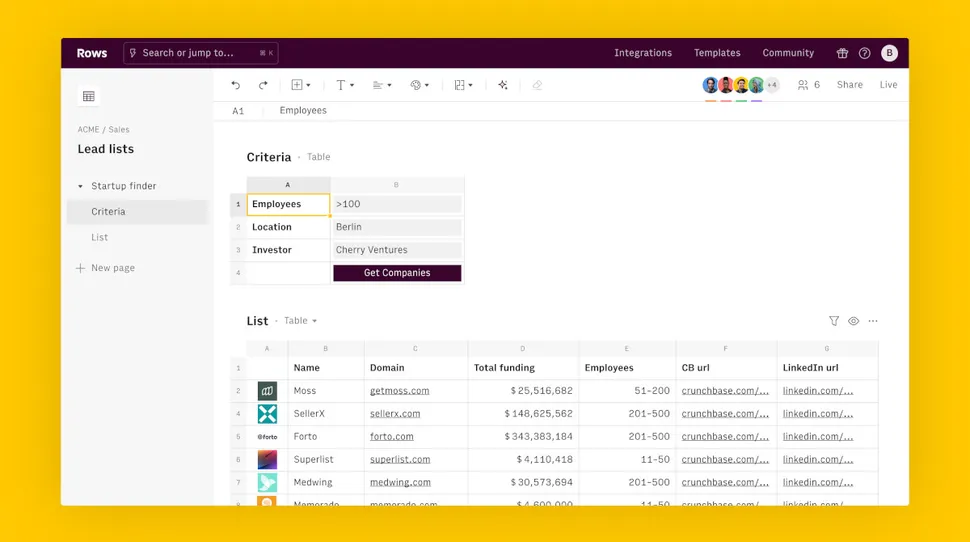
The tyranny of Microsoft Excel may finally be over
Spreadsheet software company Rows has launched a beta version of a new desktop application designed to undermine the dominance of Microsoft Excel and Google Sheets.
The company released the beta in stealth back in December, but has now gone public with native applications for both Windows and macOS, TechRadar Pro can reveal.
Until now, Rows has been available exclusively as a web app, which had placed a limit on performance. However, the company says the new desktop clients will support complex and large-scale sheets as efficiently as the market leaders, as well as providing a foundation for some functionalities only available with Rows.
Spreadsheets, but different
The central ethos behind the Rows project is that the spreadsheet software market is ripe for disruption. The duopoly of Microsoft and Google has led to a dearth of innovation, the company believes, leaving the door wide open for an ambitious challenger.
“Let’s face it. Spreadsheets suck,” said Humberto Ayres Pereira, Rows co-founder and CEO. “The business world still runs on them but they’re slowing us down. Rows is bringing the beloved spreadsheet into the modern working world.”
The company has not been shy about its ambitions to topple the incumbents. As part of a recent marketing campaign, Rows rented billboard space close to the Microsoft headquarters and erected a sign that read: “Dear Microsoft, your spreadsheet has been at it for 36 years. It’s time to retire.” And Google was given the same treatment.
To understand what distinguishes Rows from every other spreadsheet software, we spoke to Renan Araújo, who is heading up the development of the desktop app. Although Rows features all the familiar spreadsheet functionality – cells, rows, columns, functions, tables etc. – the service differs from Excel and Sheets in a few crucial ways, he told us.

Most significantly, Rows has focused closely on the ability to integrate third-party APIs into spreadsheets, with little to no coding expertise required. In practice, this means someone could easily draw data from services as diverse as Twitter, Stripe and Google Analytics into their sheets, in a way that would require a mastery of Excel.
Rows spreadsheets can also be configured to update themselves at regular intervals. In an example shown to us by Araújo, a spreadsheet was set to update every 60 seconds with new pricing information from the Amazon marketplace, effectively allowing for real-time price comparison.
Another unique feature is the ability to turn Rows spreadsheets into simple web apps that can then be let loose on the public. For example, someone could turn a Rows sheet into a landing page that collects information from customers, without having to meddle with HTML and JavaScript or pay for a third-party service.
“Building spreadsheets is a kind of programming – it’s a visual programming language,” said Araújo. “But bringing this kind of flexibility to spreadsheets takes things to a whole other level.”
Elephant in the room
The main problem facing Rows is the extent to which Microsoft and Google services are embedded in the professional world, creating a platform effect that can be difficult to overcome.
Excel and Sheets are both just small parts of much wider software and services bundles that encompass email, productivity tools, calendaring, collaboration software, cloud storage, VPN and more.
In the case of Microsoft, the company is able to establish synergies between products that extend all the way out to the Windows operating system on which most business computers run.
As a result, companies like Rows must convince potential buyers that their service is not only on-par with existing apps, but also offers sufficient additional value to justify the extra line of expenditure on the balance sheet.
With fewer than 4,000 weekly users, Rows is currently a flea nipping at the heels of the giants. But the user base has expanded rapidly since the turn of the year, and the firm is confident in its growth prospects, despite the significant headwinds.

Asked why the company believes its spreadsheet software will succeed where others have failed, we were told that changing market conditions have combined with product innovation to create a window of opportunity for Rows.
“The evidence we see is that our two biggest innovations (built-in integrations and sharing as a website) are strong enough drivers to lead large teams to adopt a new spreadsheet,” said Henrique Cruz, Head of Growth at Rows.
“In the past 15 years have seen three very large changes in work setup (mobile-first, APIs and explosion of SaaS, and async first), and we are the first company building a pure spreadsheet for this new world.”
To close the gap on the likes of Microsoft and Google, Rows will rely largely on virality. In other words, the company intends to let its product speak for itself.
Like other SaaS offerings, Rows is available for free to those that want to dip a toe in the water. And although the desktop beta is missing a handful of features (e.g. tables), the company says it aims to achieve parity with the web service by the end of the year.
